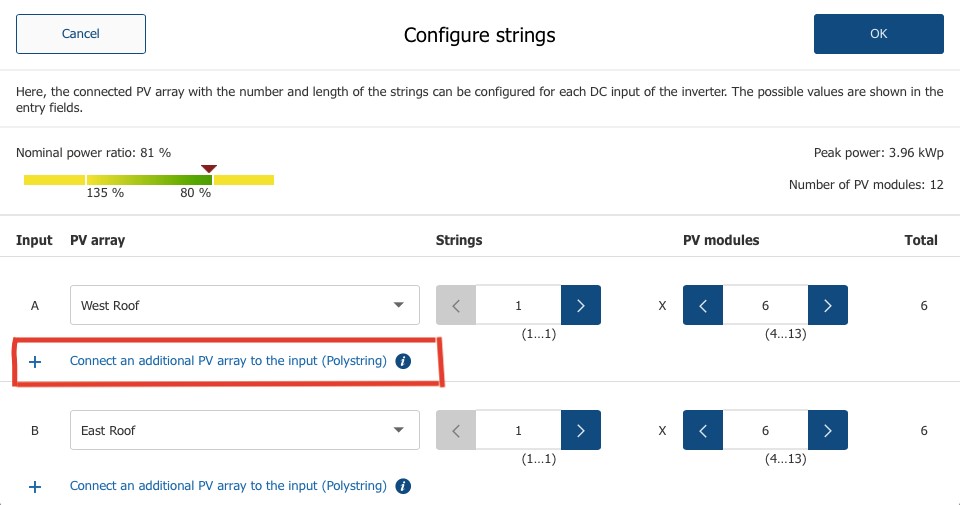How to design East/West polystring PV arrays

Have you ever heard about polystrings? Did you know that PV plants with this special plant design benefit from more energy yield over the course of the day? Sunny Design Web will help you easily design a polystring PV Array. Find out all you need to know about this key but often overlooked feature.
Imagine a scenario with limited roof space. The PV system designer may want to maximise the number of modules used. For sites in the Southern Hemisphere, this could mean PV modules are placed on North, East and West orientated roofs. Below is an example of what would be entered into Sunny Design.
In this scenario, it may appear that two Sunny Boy Inverters must be used (e.g. two SB3.0-1AV-41), since each inverter has two MPPTs. However, as a benefit of polystrings, the need for a second inverter can be eliminated. This will significantly reduce costs whilst achieving a similar annual energy yield (see figure 2).
What does polystrings mean?
The installation of polystrings means that two different PV arrays (same type of PV modules but with different orientations) can be connected in parallel at one common MPPT.

Fig 2. Screenshot from Sunny Design (Note: to compare the two alternative designs in Sunny Design , use the tabs on the top right corner of the PV system section labelled ‘add alternative’ and ‘compare alternatives’).
As an added benefit, systems with only one PV inverter can be export-controlled more easily and cost-effectively via the use of the SMA Energy Meter.
Visual Roof Planning
When configuring the PV arrays for the system design, Sunny Design’s visual roof planning tool may be a preferred alternative to the manual planning option shown in Figure 1. It provides a more visual solution and allows the installer to precisely layout modules and plan around obstacles such as chimneys and skylights. It also allows for the design to be traced around specific roofing locations by using Google satellite images.
How to find and apply Polystrings in Sunny Design?
1. In the PV system design section of the project, click on the tile shown below to configure the strings connected to the inverter.
2. This will then take you to a tab in which you can configure strings as shown below.
3. Click “Connect an additional PV array to the input (Polystring)” (highlighted in Fig 4) to add in a Polystring on MPPT A. Sunny Design Web automatically inputs the same number of modules on both polystrings. Additionally, click on the “i” symbol for more information on connecting polystrings.
4. After applying the polystring, you can check whether the inverter is compatible with the design choices.
Restrictions on Polystrings (Australia/New Zealand)
Polystrings are generally allowed in Australia/NZ so long as other requirements in the standard are followed. The most essential clauses from AS/NZS 5033:2014 related to polystrings are paraphrased below. It is important that you directly consult the standard holistically before making any design and installation decisions.
- The open circuit voltage of strings connected in parallel must be within 5%.
- Strings connected in parallel must have the same number of PV modules in series and must be of the same technology.
- It is recommended that PV modules connected to the same MPPT are of the same model.
- The series connected PV modules in a particular string must have the same orientation within 5 (azimuth and tilt angle).
Why is it ok to put strings of different orientation in parallel?
As mentioned above, the arrays in parallel must be of equal voltage for the design to be successful. A common misconception is that arrays with different orientations may have different voltages. However, the differences do not have large implications. It is ok to have these arrays that face different directions in parallel as the PV modules only require a small amount of sunlight to achieve a similar maximum power point voltage. Instead, it is the current that may significantly change – but this is not an issue for strings that are connected in parallel.

Fig 5. Power-Voltage Curve of a string of PV modules, showing that when exposed to different solar irradiances, the PV module will achieve peak power at a similar voltage (approx. 200V). Further reiterating that using polystrings to combine PV arrays that have different orientations and hence experience different solar irradiances, will not negatively affect your energy/power target.
Conclusion
By using polystrings, you can reduce costs on an extra inverter and achieve a similar energy yield. Polystrings also have the ability to simplify complex PV roof designs, allowing for one inverter to be used for arrays facing different orientations.
Want to plan your PV system with Sunny Design Web?





The polystring configuration can not be done with a SB 2.5-1VL-40 and two locations on the roof, there is some bug involved….
Hello Christer,
Please contact the SMA Service Team or our SMA Online Service Center for further support.
Kind regards
Christiane